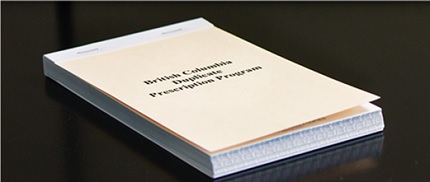Possible scenarios:
- You’re called out of an exam room to answer an urgent phone call, leaving a client alone. When you look for your controlled prescription pad later that day, you realize it’s missing.
- Your car is broken into and your briefcase containing your controlled prescription pad is taken.
- You suspect your controlled prescription pad is missing pages near the back. You confirm this by checking the folio numbers and noting they’re not consecutive.

If your controlled prescription pad is missing:
If you discover that your controlled prescription pad, or part of your pad, is missing—whether it’s lost or stolen— take these steps:
- Determine:
-
Which folios (numbered forms) are missing. If you are not able to do this, BCCNM has a record of the folio numbers.
- Whether there are
legitimate prescriptions not yet dispensed that will need to be replaced.
- Report theft or suspected theft
to the police right away.
- Call BCCNM's Controlled prescription program staff to
report the incident and get folio numbers, if necessary. 604 742-6200. Leave a message if it’s after hours.
- Contact
PharmaNet Services to
report the missing folio numbers so they can initiate a fan out. Leave a message if it’s after hours.
- Follow your
employer policy for missing controlled prescription pads.
- Reflect on the circumstances and
put safeguards in place to prevent future pad losses.
If the missing controlled prescription pad contains client information:
Missing pads that contain client information not only create privacy/confidentiality issues, but may also create client safety issues. Client names and addresses may allow others to know who has controlled drugs or substances.
If any client information is contained in the missing pad, the
BC Privacy Commissioner must be notified. This can be done by completing the
Privacy Breach Form on the Office of the Information and Privacy Commissioner (OIPC)
website.
Additional tips for keeping your controlled prescription pads secure
- Treat your pad(s) like cash or a credit card—don’t leave them unattended or unsecured.
- If you practice in multiple sites and have secure storage at each site, it’s preferable to
have a pad at each site rather than transporting them between sites.
-
Remove and file the blue/yellow prescription copies promptly. If you scan your prescription into an electronic medical record, remove the blue/yellow copy and keep it secure, shredding it as soon as possible.
If you have questions or would like more information about the
Controlled Prescription Program and CPP pads, contact
cpp@bccnm.ca.